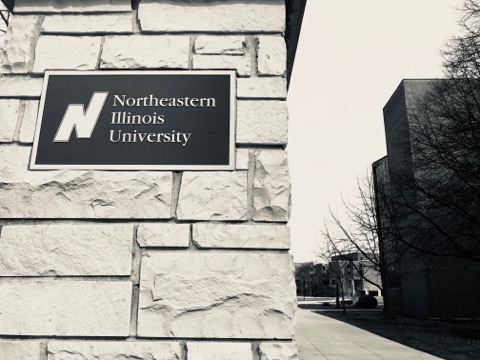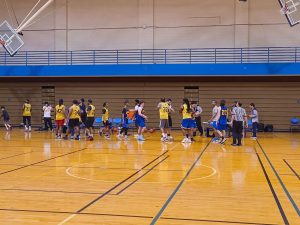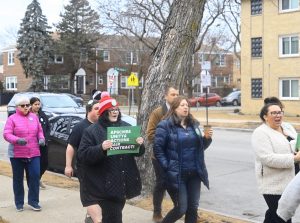NEIU instructors discuss challenges of transitioning to virtual coursework
May 18, 2020
Following Northeastern Illinois University President Dr. Gloria Gibson’s announcement that face-to-face instruction would be suspended for the remainder of the spring semester, NEIU instructors and professors were tasked with constructing a method to virtually deliver the remaining coursework.
Biology instructor Dr. Tom Campbell, yoga instructor Nancy Vankanegan, English instructor Christine Simokaitis and chemistry instructor Niroshi Meegoda spoke with the Independent about how they finished their spring classes online.
How did you prepare lessons for online teaching and was it challenging?
Campbell: This is a stressful time for many people and I think it’s important to remember that. As for my courses, I personally felt well prepared to transition online mostly because I had completed an online teaching and learning course years ago, so I was already familiar with the technology and tools. Everyone in our department rallied together and met to exchange ideas and give each other support.
Vankanegan: Like all NEIU instructors, I was saddened to lose physical contact with my students. I was grateful to have had the face-to-face experience prior to spring break. I felt that students had already learned the modifications of the yoga poses we learned, so they could practice safely. It is very different to teach on a screen.
Simokaitis: I feel that in some ways, I was in a good position to be able to transfer my classes online. For one thing, last summer, I took an online design class, a required class for faculty who want to teach online courses. In that way I was somewhat ready to teach online.
Meegoda: It was an interesting experience. I delivered online lectures via D2L during every class period. They were recorded in case if anyone misses it. Homework, quizzes and the final exam were posted online. I also posted several videos to help them understand the concepts. My lecture powerpoints were already in D2L.
Was it hard for students to transition to the online model?
Campbell: It was harder to prepare the students, many of whom did not ask for nor sign up for online learning. I think learning online full-time is very different from normal lecture-based learning. I don’t want the technology to be a barrier for them or myself. After all, it’s the content they signed up for to learn.
Vankanegan: Teaching Philosophy content transitioned well to online but the physical practice of asana has distinct difficulties when moved online. I am not able to walk around the classroom assisting students.
Simokaitis: I still had to scramble to create discussion boards, make videos and plan out how it was all going to work. I was really worried about my students and their families. I had no idea whether or not the new forum could work for them.
Meegoda: The biggest challenge was to do labs. Luckily my class had only two wet labs left to do. So I gave guidelines to the students to do the cabbage pH indicator lab at home using red cabbage and household chemicals. They did a very nice job and uploaded the results with photographs in [Desire2Learn]. The challenge during delivering lectures was not having the ability to write on the board. I tried writing on the slides using the mouse but it was difficult.
What did you learn from teaching online?
Campbell: I think it’s important to be flexible and caring. Our students might be under a variety of pressures other than school, especially now. I felt it was important to remain flexible and be open to student concerns.
Vankanegan: The end of this term was a good intro into online teaching for me and gave me the opportunity to assess my reliance on face to face contact.
Simokaitis: I just read my course evaluations and was surprised to read a comment from one student saying they felt more engaged after we went online. I am glad that I had a general “what are you noticing” discussion board, which was set up as an in-class exercise to hone observation skills for creative writing. Online discussions served well as an online check-in for everyone each week, so we could stay connected during difficult times.
Meegoda: I extended all deadlines to give students more time to complete assignments. With everything going on, it can be very overwhelming. It is important to be more flexible with the assignments.
How has student engagement changed by not having to come to class, or did you have to modify anything to be able to keep students engaged?
Campbell: Overall, I think our students are very resilient and have adapted well to online courses. But, of course, some enjoy the online experience more than others.
Vankanegan: I often walk around the class assisting students. Internet teaching is less interactive and does not allow me to see students who struggle with assignments. I was conscious of being perfectly clear, so students would not feel lost.
Simokaitis: I was very pleasantly surprised by all of the activity and discussion in my classes and felt a huge wave of relief that most of my students seemed to be okay.
Meegoda: I had a good group of students attending online lectures regularly and doing all of the assignments. I noticed students were asking more questions using the chat feature. If somebody is missing an assignment, I send several emails until they submit it.
If face-to-face instruction is still suspended for the fall semester, what concerns do you have, or do you think you are prepared to continue teaching online?
Campbell: If we were to continue to work online in the fall, it will be nice to know as soon as possible, so instructors can successfully plan out the semester. You really have to think about the different forms of technology and reliability of what students have access to.
Vankanegan: I do think that we can alter our methods to increase the interpersonal student/teacher dynamic. I’m optimistic about the shift as my technology skills increase and [I’m] hopeful that face-to-face learning will return.
Simokaitis: “I think by the fall, I could be ready for two of my three classes to be online. The third, though, is a First-Year Experience course, which will be tricky to convert. So much of the class is about introducing students to campus life (as you know), so I’ll have to spend a bit more time figuring out how to make that one work.”
Meegoda: If we are going to continue classes online in fall, I will definitely need a Surface Pro computer which allows me to write similar to the whiteboard. Also, chemistry professors need to figure out how they are going to do labs virtually. We may have to use simulations or provide students lab kits to do labs at home.










